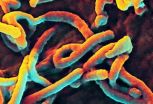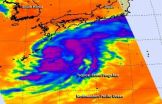(Press-News.org) In the typical textbook picture, volcanoes, such as those that are forming the Hawaiian islands, erupt when magma gushes out as narrow jets from deep inside Earth. But that picture is wrong, according to a new study from researchers at Caltech and the University of Miami in Florida.
New seismology data are now confirming that such narrow jets don't actually exist, says Don Anderson, the Eleanor and John R. McMillian Professor of Geophysics, Emeritus, at Caltech. In fact, he adds, basic physics doesn't support the presence of these jets, called mantle plumes, and the new results corroborate those fundamental ideas.
"Mantle plumes have never had a sound physical or logical basis," Anderson says. "They are akin to Rudyard Kipling's 'Just So Stories' about how giraffes got their long necks."
Anderson and James Natland, a professor emeritus of marine geology and geophysics at the University of Miami, describe their analysis online in the September 8 issue of the Proceedings of the National Academy of Sciences.
According to current mantle-plume theory, Anderson explains, heat from Earth's core somehow generates narrow jets of hot magma that gush through the mantle and to the surface. The jets act as pipes that transfer heat from the core, and how exactly they're created isn't clear, he says. But they have been assumed to exist, originating near where the Earth's core meets the mantle, almost 3,000 kilometers underground—nearly halfway to the planet's center. The jets are theorized to be no more than about 300 kilometers wide, and when they reach the surface, they produce hot spots.
While the top of the mantle is a sort of fluid sludge, the uppermost layer is rigid rock, broken up into plates that float on the magma-bearing layers. Magma from the mantle beneath the plates bursts through the plate to create volcanoes. As the plates drift across the hot spots, a chain of volcanoes forms—such as the island chains of Hawaii and Samoa.
"Much of solid-Earth science for the past 20 years—and large amounts of money—have been spent looking for elusive narrow mantle plumes that wind their way upward through the mantle," Anderson says.
To look for the hypothetical plumes, researchers analyze global seismic activity. Everything from big quakes to tiny tremors sends seismic waves echoing through Earth's interior. The type of material that the waves pass through influences the properties of those waves, such as their speeds. By measuring those waves using hundreds of seismic stations installed on the surface, near places such as Hawaii, Iceland, and Yellowstone National Park, researchers can deduce whether there are narrow mantle plumes or whether volcanoes are simply created from magma that's absorbed in the sponge-like shallower mantle.
No one has been able to detect the predicted narrow plumes, although the evidence has not been conclusive. The jets could have simply been too thin to be seen, Anderson says. Very broad features beneath the surface have been interpreted as plumes or super-plumes, but, still, they're far too wide to be considered narrow jets.
But now, thanks in part to more seismic stations spaced closer together and improved theory, analysis of the planet's seismology is good enough to confirm that there are no narrow mantle plumes, Anderson and Natland say. Instead, data reveal that there are large, slow, upward-moving chunks of mantle a thousand kilometers wide.
In the mantle-plume theory, Anderson explains, the heat that is transferred upward via jets is balanced by the slower downward motion of cooled, broad, uniform chunks of mantle. The behavior is similar to that of a lava lamp, in which blobs of wax are heated from below and then rise before cooling and falling. But a fundamental problem with this picture is that lava lamps require electricity, he says, and that is an outside energy source that an isolated planet like Earth does not have.
The new measurements suggest that what is really happening is just the opposite: Instead of narrow jets, there are broad upwellings, which are balanced by narrow channels of sinking material called slabs. What is driving this motion is not heat from the core, but cooling at Earth's surface. In fact, Anderson says, the behavior is the regular mantle convection first proposed more than a century ago by Lord Kelvin. When material in the planet's crust cools, it sinks, displacing material deeper in the mantle and forcing it upward.
"What's new is incredibly simple: upwellings in the mantle are thousands of kilometers across," Anderson says. The formation of volcanoes then follows from plate tectonics—the theory of how Earth's plates move and behave. Magma, which is less dense than the surrounding mantle, rises until it reaches the bottom of the plates or fissures that run through them. Stresses in the plates, cracks, and other tectonic forces can squeeze the magma out, like how water is squeezed out of a sponge. That magma then erupts out of the surface as volcanoes. The magma comes from within the upper 200 kilometers of the mantle and not thousands of kilometers deep, as the mantle-plume theory suggests.
"This is a simple demonstration that volcanoes are the result of normal broad-scale convection and plate tectonics," Anderson says. He calls this theory "top-down tectonics," based on Kelvin's initial principles of mantle convection. In this picture, the engine behind Earth's interior processes is not heat from the core but cooling at the planet's surface. This cooling and plate tectonics drives mantle convection, the cooling of the core, and Earth's magnetic field. Volcanoes and cracks in the plate are simply side effects.
The results also have an important consequence for rock compositions—notably the ratios of certain isotopes, Natland says. According to the mantle-plume idea, the measured compositions derive from the mixing of material from reservoirs separated by thousands of kilometers in the upper and lower mantle. But if there are no mantle plumes, then all of that mixing must have happened within the upwellings and nearby mantle in Earth's top 1,000 kilometers.
The paper is titled "Mantle updrafts and mechanisms of oceanic volcanism."
INFORMATION:
Textbook theory behind volcanoes may be wrong
2014-09-08
ELSE PRESS RELEASES FROM THIS DATE:
UCLA biologists delay the aging process by 'remote control'
2014-09-08
UCLA biologists have identified a gene that can slow the aging process throughout the entire body when activated remotely in key organ systems.
Working with fruit flies, the life scientists activated a gene called AMPK that is a key energy sensor in cells; it gets activated when cellular energy levels are low.
Increasing the amount of AMPK in fruit flies' intestines increased their lifespans by about 30 percent — to roughly eight weeks from the typical six — and the flies stayed healthier longer as well.
The research, published Sept. 4 in the open-source journal Cell ...
Rapid and durable protection against ebola virus with new vaccine regimens
2014-09-08
One shot of an experimental vaccine made from two Ebola virus gene segments incorporated into a chimpanzee cold virus vector (called chimp adenovirus type 3 or ChAd3) protected all four macaque monkeys exposed to high levels of Ebola virus 5 weeks after inoculation, report National Institutes of Health (NIH) scientists and their collaborators. The ability of the ChAd3 Ebola virus vaccine to elicit rapid protection in monkeys is notable as the world health community battles an ongoing Ebola virus disease outbreak in West Africa. While the protective effects of the single ...
Teens living with 2 college-educated parents less likely to use alcohol and marijuana
2014-09-08
ARLINGTON, Texas -- A high school senior who lives with two college-educated parents is significantly less likely to drink alcohol or smoke marijuana than a teenager who lives with one parent, a new University of Texas at Arlington study has found.
For example, teens living with their mother only are 54 percent more likely to use alcohol, and 58 percent more likely to smoke if they live only with their father.
Eusebius Small, an assistant professor in the UT Arlington School of Social Work, analyzed data on 14,268 teenagers to determine the impact of family structure ...
Ohio University paleontologists discover new species of titanosaurian dinosaur in Tanzania
2014-09-08
ATHENS, Ohio (Sept. 8, 2014)—Ohio University paleontologists have identified a new species of titanosaurian, a member of the large-bodied sauropods that thrived during the final period of the dinosaur age, in Tanzania. Although many fossils of titanosaurians have been discovered around the globe, especially in South America, few have been recovered from the continent of Africa.
The new species, named Rukwatitan bisepultus, was first spotted by scientists embedded in a cliff wall in the Rukwa Rift Basin of southwestern Tanzania. Using the help of professional excavators ...
In one of nature's innovations, a single cell smashes and rebuilds its own genome
2014-09-08
Life can be so intricate and novel that even a single cell can pack a few surprises, according to a study led by Princeton University researchers.
The pond-dwelling, single-celled organism Oxytricha trifallax has the remarkable ability to break its own DNA into nearly a quarter-million pieces and rapidly reassemble those pieces when it's time to mate, the researchers report in the journal Cell. The organism internally stores its genome as thousands of scrambled, encrypted gene pieces. Upon mating with another of its kind, the organism rummages through these jumbled genes ...
Gobbling up poison: A method for killing colon cancer
2014-09-08
(PHILADELPHIA) – These days, cancer researchers aim to design targeted and specific therapy – those that kill cancer but spare the surrounding tissue. Immunotoxins, which use cancer-targeted antibodies linked to deadly toxins such as ricin, are one such therapy. However, few have succeeded to date in part because cancer cells share many molecules with normal cells, and because it can be challenging to unlock the deadly chemical only after the antibody has homed to the diseased tissue.
Now researchers at Thomas Jefferson University have discovered the unique biological ...
Soft robot squirms over fire, ice, and withstands crushing force
2014-09-08
ITHACA, N.Y. – Engineers have created a shape-changing "soft" robot that can tread over a variety of adverse environmental conditions including snow, puddles of water, flames, and the crushing force of being run over by an automobile.
Videos: https://cornell.box.com/softrobot
The engineers from Cornell and Harvard Universities will detail the robot in an upcoming edition of the journal Soft Robotics. An early online version of the study can be found at: http://online.liebertpub.com/doi/full/10.1089/soro.2014.0008
The pneumatically powered, fully untethered robot was ...
NASA sees large Tropical Storm Fengshen skirting eastern Japan's coastline
2014-09-08
Tropical Storm Fengshen is a large storm and infrared imagery from NASA's Aqua satellite shows that it's about as long as the big island of Japan.
NASA's Aqua satellite passed over Tropical Storm Fengshen on September 7 and the Atmospheric Infrared Sounder instrument known as AIRS gathered temperature data about the storm's cloud tops and surrounding sea surface temperatures. The infrared data showed strong thunderstorms surrounded the center of circulation and also appeared in large bands south and northeast of the storm's center. Another large and fragmented band on ...
Yale study shows how conversion of forests to cropland affected climate
2014-09-08
The conversion of forests into cropland worldwide has triggered an atmospheric change that, while seldom considered in climate models, has had a net cooling effect on global temperatures, according to a new Yale study.
Writing in the journal Nature Climate Change, Professor Nadine Unger of the Yale School of Forestry & Environmental Studies (F&ES) reports that large-scale forest losses during the last 150 years have reduced global emissions of biogenic volatile organic compounds (BVOCs), which control the atmospheric distribution of many short-lived climate pollutants, ...
Brain damage caused by severe sleep apnea is reversible
2014-09-08
DARIEN, IL – A neuroimaging study is the first to show that white matter damage caused by severe obstructive sleep apnea can be reversed by continuous positive airway pressure therapy. The results underscore the importance of the "Stop the Snore" campaign of the National Healthy Sleep Awareness Project, a collaboration between the Centers for Disease Control and Prevention, American Academy of Sleep Medicine, Sleep Research Society and other partners.
Results show that participants with severe, untreated sleep apnea had a significant reduction in white matter fiber integrity ...




